Tattoo trends are constantly evolving, with people seeking unique ways to express themselves through body art. Among the fascinating trends gaining traction are Uv Tattoos, also known as black light tattoos. These tattoos use a special ink that is almost invisible in normal light but glows vibrantly under ultraviolet or black light. Often likened to having a secret superpower, UV tattoos offer a subtle yet striking way to enhance your personal style.
While we’re still waiting for the much-anticipated “smart tattoo” that promises to monitor health metrics, UV tattoos provide a different kind of cutting-edge appeal. They offer a unique aesthetic that traditional tattoos can’t match, creating an element of surprise and intrigue.
UV tattoos are created using ultraviolet-reactive ink. It’s crucial to understand that black light tattoos do not glow in the dark in the same way glow-in-the-dark stickers do. Instead, they become visible and luminous when exposed to a black light. This distinction is important for anyone considering getting a UV tattoo, as the effect is specifically activated by UV light, not just darkness.
UV tattoos are increasingly popular for adding a creative twist to traditional tattoo art. When applied skillfully, UV ink can elevate a tattoo’s design, making it appear as though it was specifically intended for black light effects. They can enhance existing tattoo concepts, such as making a UFO beam glow or adding subtle, glowing details to intricate designs.
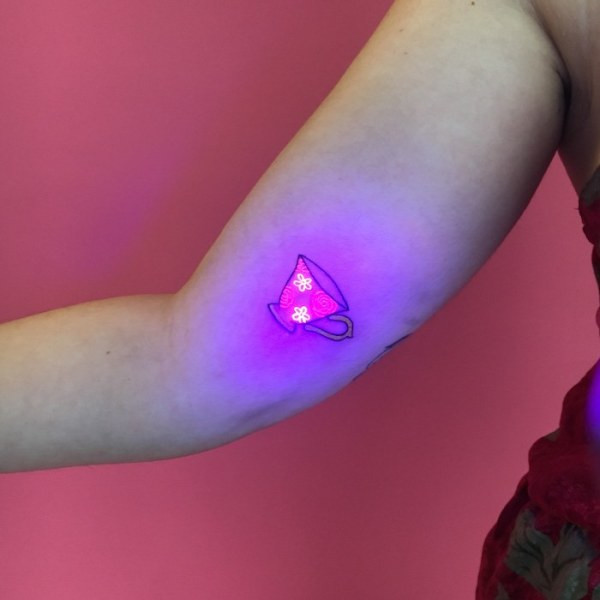 Detailed view of a teacup tattoo with UV ink accents, glowing brightly under black light.
Detailed view of a teacup tattoo with UV ink accents, glowing brightly under black light.
However, working with UV ink presents unique challenges. Tattoo artists note that UV ink is thinner and more difficult to handle than traditional tattoo inks. This characteristic underscores the importance of choosing a reputable tattoo artist and studio with proven experience in UV tattoos. To gain deeper insights into the nuances of UV tattoos, we spoke with tattoo artists who specialize in this distinctive style.
The UV Tattoo Application Process: What to Expect
Quinton McCloud, a tattoo artist at Karmic Tattoo in South Atlanta, shared his initial experience with black light tattoos, emphasizing a cautious approach to achieve the desired “glow” effect.
“Because it was my first time doing it, I just wanted to test it out by putting a little here and there,” McCloud explained, describing his first UV tattoo—a gecko wearing a party hat. The UV ink was strategically placed to highlight details like fingernails, the party hat, and confetti, showcasing the potential for subtle yet impactful glowing accents.
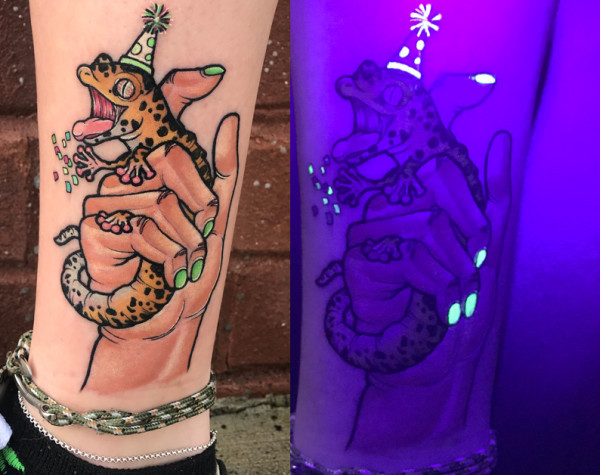 Image of a gecko tattoo with UV ink highlights on fingernails and party hat, glowing under UV light.
Image of a gecko tattoo with UV ink highlights on fingernails and party hat, glowing under UV light.
McCloud’s interest in UV tattoos was initially met with skepticism during his apprenticeship. “I asked him why I never really saw or heard of anyone getting them, and he told me that the only place you could get UV ink at the time was from sources that weren’t really trustworthy tattoo suppliers, like eBay and Amazon,” he recalled. This highlights a past concern about the quality and safety of UV inks available in the market.
However, the landscape changed when reputable suppliers started offering UV inks. McCloud discovered Kurosumi Ink’s UV pigment line, Kuro Sumi Glow. “They released green, red, pink, etc., so I ordered the green to give it a try,” he said, marking a turning point in the accessibility of professional-grade UV inks.
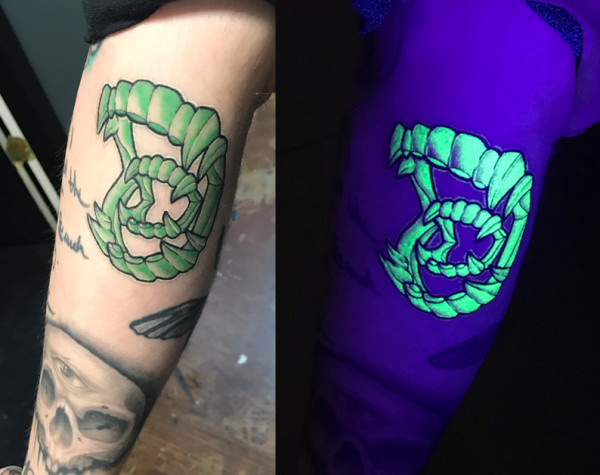 Close-up of a Xenomorph teeth tattoo, showcasing the application of UV ink to create a glowing effect.
Close-up of a Xenomorph teeth tattoo, showcasing the application of UV ink to create a glowing effect.
For another project, McCloud tattooed a Xenomorph-inspired design using plastic vampire teeth as a reference. He experimented with needle types, noting, “With the teeth, I used a shader on the whole thing and it got super irritated in the skin. This was weird because I run my machine pretty low, and it’s very rare that my tattoos get anywhere near as irritated as this was.” This observation points to the importance of technique and skin sensitivity when working with UV inks.
Kayla Newell, a tattoo artist at Secret Club Tattoo in Portland, Oregon, shared a cautionary tale from her early experiences with UV ink. “My first blacklight tattoo was self-administered and done using this terrible quality UV pink ink that I found on Amazon. It was some Skin Candy knock-off brand that I think I bought because it was the cheapest shit on there. It definitely shows,” Newell admitted.
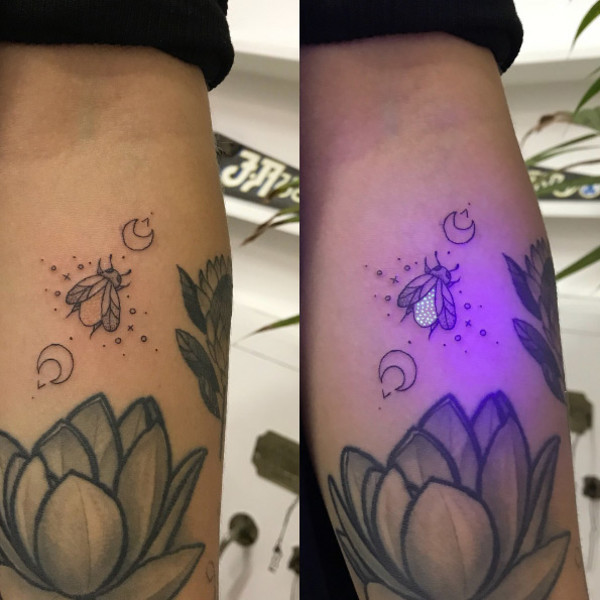 Image of a faded pink UV tattoo, illustrating the potential issues with low-quality UV ink.
Image of a faded pink UV tattoo, illustrating the potential issues with low-quality UV ink.
“All of the pink ink has nearly faded but the strange thing is that it does still glow under a blacklight. But I would not recommend this route to anyone else.” Newell’s experience serves as a strong warning against using unverified, low-quality UV inks, emphasizing the risks of fading and unpredictable results.
Tattooing Techniques for UV Ink
Tukoi Oya, an Australian tattoo artist, approaches UV tattoos with a bold “rave til the grave” attitude. He described the consistency of UV ink: “The consistency of the brand I use is pretty thin and opaque, so when you’re doing solid patches of color you need to be really careful not to overwork the skin, because it feels like more of a grey wash than normal color to apply.”
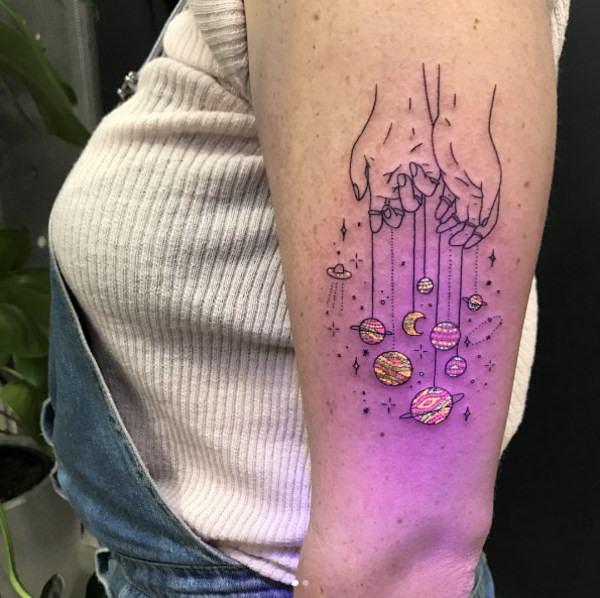 Abstract tattoo with UV ink elements, showcasing the pastel and subtle appearance in daylight.
Abstract tattoo with UV ink elements, showcasing the pastel and subtle appearance in daylight.
Oya further noted the healed appearance of UV tattoos: “When they are healed they also have a kind of pastel and watered-down look, so you can see the phosphorus reflect through it.” He recommends lighter colors for UV ink, stating, “I only rate the lighter colors,” like yellow, pink, orange, and green, adding, “the purples and blues do not reflect as bright with the UV light because they’re darker pigments.” For aftercare, Oya recommends Dr. Pickles, particularly for fine-line tattoos, considering it “the best stuff.”
Samantha Ceora of Ceora Ink in LA, highlighted the importance of preventing stencil contamination to maintain the “invisible effect” of UV tattoos. “The tattoo is done with a plastic disposable tip to avoid any discoloration. I also remove the stencil almost completely to avoid any trace of the ink contaminating the tattoo. The machine has to be turned down low and a uv light must be used periodically throughout the process,” Ceora explained.
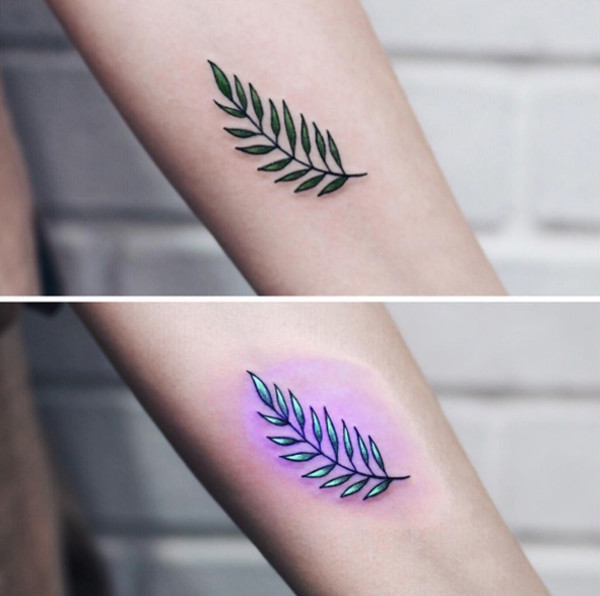 Artist applying a UV tattoo, using a UV light to check the ink visibility during the process.
Artist applying a UV tattoo, using a UV light to check the ink visibility during the process.
Ceora also emphasized technique for skin safety: “One last thing is I make sure to get the ink in 1-3 passes max, to ensure the skin’s safety from scarring. After all, the whole point is to create an invisible tattoo.” This highlights the delicate balance between achieving the UV effect and minimizing skin trauma.
Newell echoed the sentiment that the tattooing process is largely similar to traditional tattooing, with the main difference being the ink itself. “The neon inks I use are pretty thick, much like white ink, so you have to be careful that it doesn’t separate or mix with any other colors once it’s been laid in,” she advised. “If it gets anything too dark even smeared into it, it can negatively affect its ability to glow.”
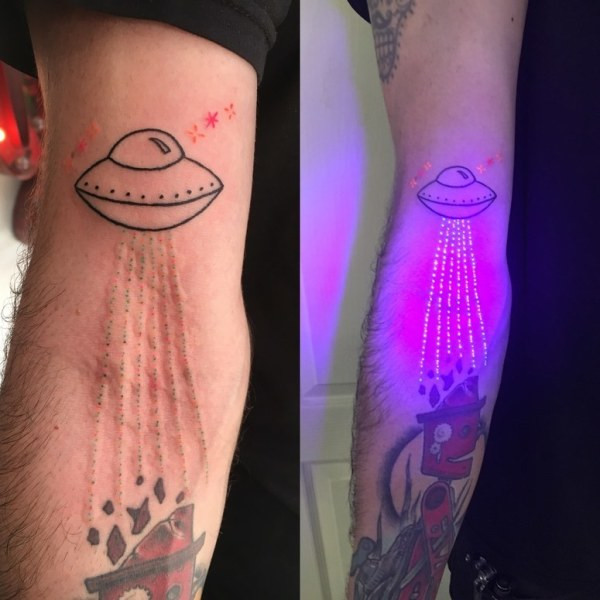 UFO tattoo with glowing beam effect achieved using UV black light ink.
UFO tattoo with glowing beam effect achieved using UV black light ink.
Design Ideas for UV Tattoos
When it comes to design, subtlety can be key with UV tattoos. Tukoi Oya suggests, “I feel like when you add some UV here and there it looks best. Don’t go overboard with it. I find it looks best just doing small dots or small sections of color though.” He also advises on color application, “Because they’re lighter pigments it’s important to keep it really clean so you don’t stain the skin when it’s healing, like a white tattoo. But it’s the same as normal.”
Newell recommends bold designs: “Anything really bold looks good in neon, especially when it’s done right next to a dark color, so that it pops. That’s why I like doing the 3-D effect in black and pink or blue and red.” This suggests that contrasting UV ink with darker, traditional inks can enhance the visual impact of the tattoo.
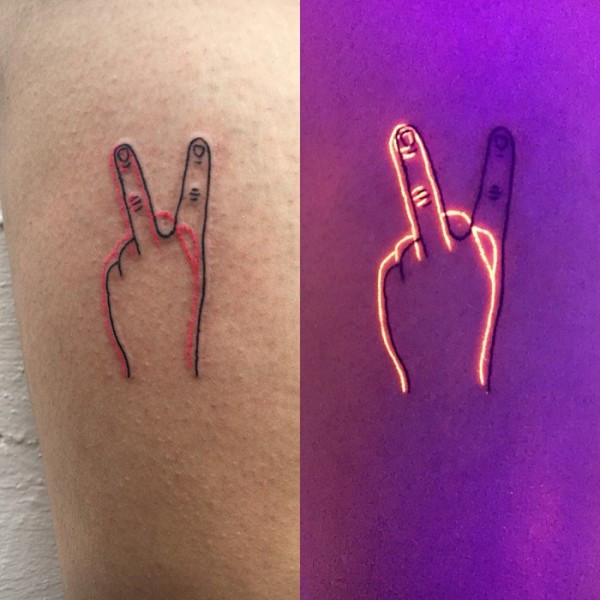 Bold line-work tattoo enhanced with UV ink, creating a vibrant contrast under black light.
Bold line-work tattoo enhanced with UV ink, creating a vibrant contrast under black light.
Healing and Aftercare for UV Tattoos
Proper aftercare is crucial for all tattoos, and UV tattoos are no exception. Ceora recommends a protective approach immediately after tattooing: “Usually I will layer some ink on top of the tattoo after finishing, and use SecondSkin bandage to seal it for 4-24 hours so the skin holds the ink.”
Newell confirms that aftercare for UV tattoos is “exactly the same in every way” as for traditional tattoos. She also mentions her preferred ink brands: “I use Waverly Colors made in Baltimore, Maryland. I also have a few custom colors that I was recently gifted, made by Northwest Pigments, that I’m very excited about.” Choosing reputable ink brands is essential for both the vibrancy and longevity of UV tattoos.
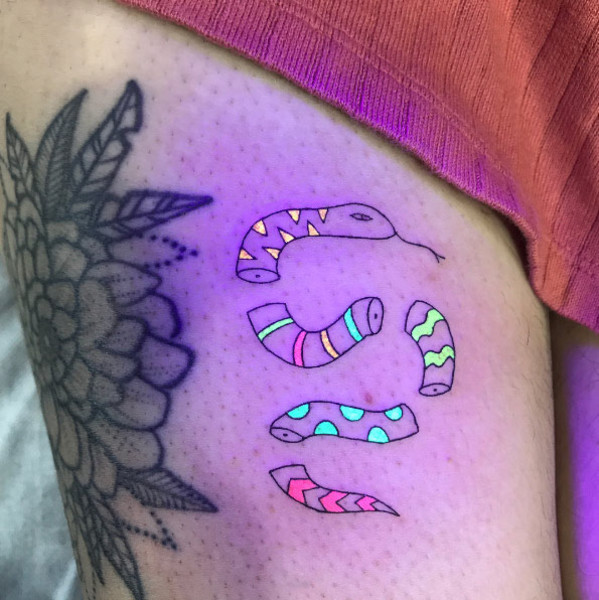 Close-up of a healed UV tattoo, demonstrating the subtle appearance in daylight and potential for long-lasting visibility under UV light.
Close-up of a healed UV tattoo, demonstrating the subtle appearance in daylight and potential for long-lasting visibility under UV light.
Longevity of UV Tattoos
The lifespan of UV tattoos can vary. Ceora states, “I’ve seen them last years. Though, it’s kind of a gamble. Everyone’s skin is different. The aftercare instructions need to be taken seriously and gently. Anyone considering a UV tattoo should seek out an experienced artist with the ink.” She also adds a note of caution, “And consider a wide range of unknown side effects,” highlighting the importance of being aware of potential risks.
Oya provides a slightly more specific estimate: “They last about 5 years and they’ll gradually start to fade, just like a normal tattoo would over time. But that said, I saw a UV tattoo I did about a year-and-a-half ago the other day, and it’s still looking hella fresh.” While UV tattoos can last for several years, fading over time is a natural process, similar to traditional tattoos.
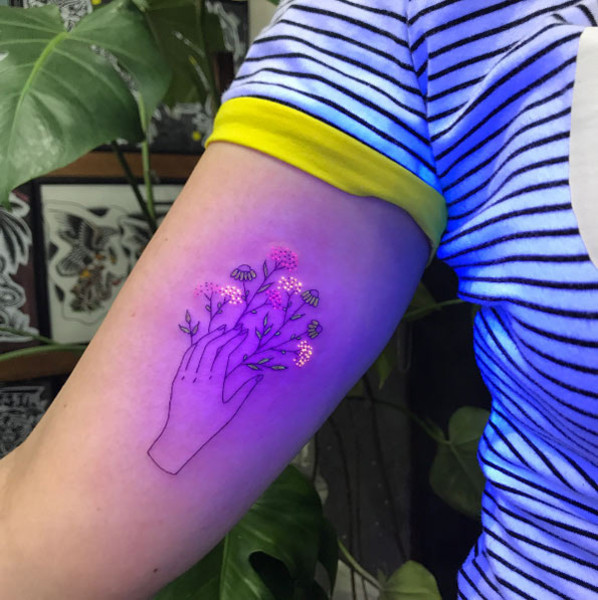 Example of a UV tattoo glowing under black light, illustrating the long-term visibility potential.
Example of a UV tattoo glowing under black light, illustrating the long-term visibility potential.
Potential Side Effects and Safety Concerns
It’s important to consider the safety aspects of UV tattoos. The U.S. Food and Drug Administration (FDA) has not approved any tattoo inks for injection into the skin, including UV inks. The FDA notes that “many pigments used in tattoo inks are industrial-grade colors suitable for printers’ ink or automobile paint.” This general lack of regulation for tattoo inks applies to UV inks as well.
Concerns have been raised about the long-term effects of UV tattoos.
Arash Akhavan, a dermatologist based in New York City, points out a specific concern: “Phosphorus is a popular ingredient to achieve the glow-in-the-dark effect, and there are some concerns that in high doses it can be carcinogenic.” While UV inks are not glow-in-the-dark and use different reactive components, this highlights a general caution about substances that create glowing effects in cosmetic applications.
Ceora shared her observation of adverse reactions: “I have only seen one out of 25 people have a bad reaction. They had some scarring and irritation, and loss of glow,” attributing it to “my amateur status at the time, and the brand of ink. Plus the person had extensive allergies to random things.” This underscores the combined importance of artist experience, ink quality, and individual skin sensitivities.
 Portrait of tattoo artist Ceora Ink, emphasizing expertise and experience in UV tattoos.
Portrait of tattoo artist Ceora Ink, emphasizing expertise and experience in UV tattoos.
Oya uses Firefly ink, sourced from Protat, a major Australian tattoo supplier. “Its not FDA approved, but all of the UV tattoos I’ve done have healed up really nicely. There is phosphorus in so many things though, like washing powder, paper, and even some foods like potatoes. Literally anything that glows with a black light.” Oya’s perspective suggests a degree of acceptance of phosphorus in everyday products, while still acknowledging the lack of FDA approval specifically for UV tattoo inks.
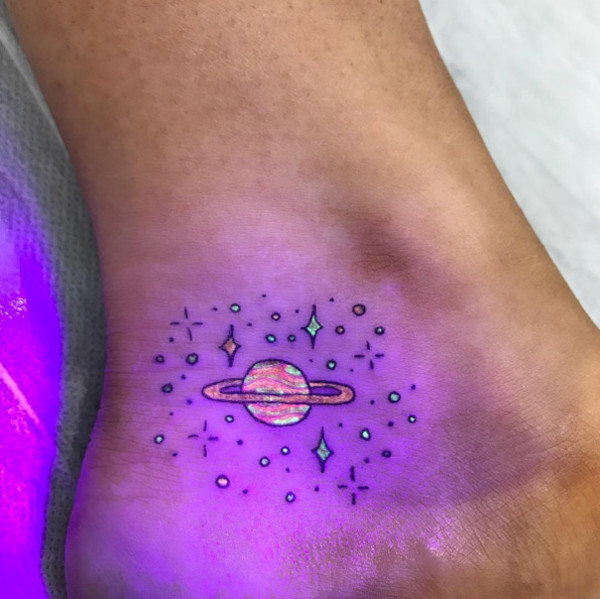 Image of various everyday items that glow under black light, contextualizing the presence of phosphorus in common materials.
Image of various everyday items that glow under black light, contextualizing the presence of phosphorus in common materials.
The Allure of UV Tattoos
Despite the considerations, UV tattoos hold a unique appeal. Newell explains her initial attraction to UV ink: “When I first started tattooing I really wanted to make stuff that looked like my paintings; abstract, geometric and wild colors. I had bought this ink at the local supply shop that was the most vivid, brightly colored neon pink I had ever seen and I already knew it would glow under blacklight just from the naturally fluorescent quality.”
Newell also emphasizes education and dispelling misconceptions: “Part of my mission was to get people to understand how it worked, the difference between my tattoos and the “glow in the dark” tattoos that gave people diseases, and the fact that there are non-harmful, blacklight-reactive tattoos.” This highlights the effort to differentiate safe UV tattoos from potentially harmful glow-in-the-dark substances and to educate the public about this art form.
“Aside from that,” Newell concludes, “the act of seeing yourself glow under a blacklight is pretty magical, and that is hard to deny once you’ve seen it in real life.” Ultimately, the magic and novelty of UV tattoos, the subtle daytime appearance transforming into a vibrant glow under black light, is a significant part of their enduring appeal.
